APRIL FOOL’S GOLD: Acadia Center Responds to Latest Fossil Fuel Interest Attacks on Clean Energy Policies in New England
MEDIA CONTACT:
Kyle Murray
Director, State Program Implementation
kmurray@acadiacenter.org, 617-742-0054 ext.106
No, it’s not an April Fool’s Day prank: following their easily debunked November energy cost report, fossil fuel-interest think tanks are back with a new round of the same tired and misguided attacks against clean energy policies in New England. Today, the groups – including Americans for Prosperity, the Josiah Bartlet Center for Public Policy, the National Federation of Independent Businesses, the Maine Policy Institute, Massachusetts Fiscal Alliance, and Rhode Island Center for Freedom and Prosperity – held an online press conference to discuss “the effects of alternative energy mandates on the region’s taxpayers.” Since their last flawed analyses, New Englanders have endured a cold and costly winter when it comes to energy bills. The tally of these costs lays bare the region’s untenable overreliance on fossil fuels, with rising energy burdens driven by natural gas infrastructure, generous utility profits, and the region’s continued fossil fuel investments – all exacerbated by reckless actions from the Trump Administration.
With the costs of New England’s fossil fuel reliance growing, clean energy and energy efficiency now have the potential to deliver even greater benefits to families and businesses across the region, by mitigating and avoiding precisely the kind of price spikes seen this winter. New England wholesale electricity costs exceeded $10 billion in 2024 for the third time in four years, a period that saw natural gas grow to unprecedented levels of overreliance (51% of net energy for load in 2024). One program giving payments to dual-fuel (gas-oil) power plants, the inventoried energy program (IEP), cost ratepayers almost $80 million over just five days this winter. And gas heating customers felt the pain too, with natural gas spiking to an average of almost $17/MMBtu in the month of January (a 120% increase over the prior January), and the region’s growing gas distribution networks pushing up delivery costs to previously unseen levels. Energy efficiency programs like Mass Save, touted as the Boogeyman for rising costs, are actually saving customers money by preventing needless additional expenditures on fossil fuels at such costly rates. For example, Rhode Island’s 2024-2026 energy efficiency plan is helping avoid almost $50m in added costs if load was instead met by purchasing additional electric supply.
Figure 1 and 2: New England Wholesale Electricity Costs and Sources of Grid Electricity (source: ISO-NE)
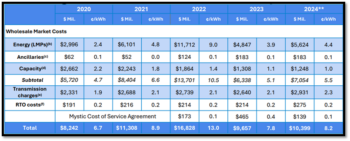
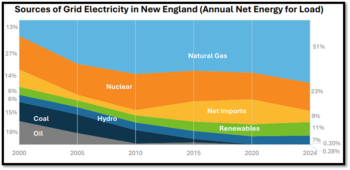
The takeaway for the region remains true: New England has a once-in-a-generation opportunity to redesign and revolutionize its energy system with clean energy and localize the job-creation and GDP impact of energy expenditures within the regional economy, rather than export them afar. Right now, the region has almost all its eggs in the fossil fuel basket, and this offers only the false promise of fool’s gold in protecting the region’s consumers from rising energy bills. The region must double down on its climate and clean energy goals to make the broader northeast region energy independent from fossil fuels, reduce consumer price spikes, and mitigate the economic harms of worsening climate change.
It’s time to set the record straight once again:
False claim #1: the region’s aggressive renewable climate energy policies are a major driver of high utility bills in New England.
Don’t let them fool you: New England spends $76b per year on energy, the majority of which still goes to fossil fuels from outside the region (source: EIA data for 2022). Plus, it was very, very cold this winter; the coldest winter since 2014-2015, in fact.[1] According to data compiled by Acadia Center (see figure 3 and 4 below), the average temperature in December 2024 was a full 10°F colder than December 2023. Further, from December 2024 through February 2025, Massachusetts saw 23 days colder than 20°F, compared to only nine such days the year prior. These colder temperatures generally mean that residents are using more energy, driving up bills.
Figures 3 and 4: Quantifying Winter 2024-2025 Cold Intensity (source: Acadia Center)
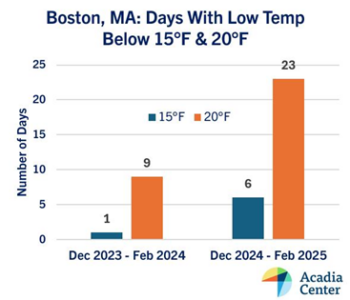
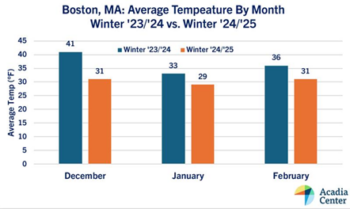
However, due to the Commonwealth’s overreliance on natural gas and other fossil fuels, it also means higher costs for the supply of energy. As America exports more liquefied natural gas (LNG) abroad, domestic gas prices are increasingly tied to the unpredictability of global gas markets, leading to increased price volatility for consumers. By contrast, renewable energy contracts provide a means of locking in affordable prices/rates over a long period of time, helping hedge and insulate the region from the volatile swings in fossil fuel commodity prices seen this winter. Had the Trump Administration not brought offshore wind development to a grinding halt, more high-value offshore wind resources would be available to mitigate winter price spikes and deliver much needed winter resource adequacy in the winters to come.
On the gas side, existing gas customers pay a disproportionate share of the costs for bringing new customers online. Since 2018, existing gas customers have footed the bill for 80% of all new gas customer connections. And these subsidies – known as line extension allowances – are driving up gas bills for everyone. In 2023 alone, Massachusetts gas customers were charged $160 million to add new customers to the gas system, to the tune of $9,000 per new customer, which is reflected on ratepayer gas bills. The cost of adding new customers is rising as well: the average cost of adding new customers rose 50% between 2020-2021 and again in 2022-2023. In fact, despite an acknowledgement by the state and by utilities that we should be winding the gas system down – not expanding it – the growth of the sprawling pipe network shows no signs of stopping. According to analysis from the Attorney General’s Office in Massachusetts, the path we’re currently on could see the state’s gas rate base – the total value of gas system assets on which utilities are allowed to earn a rate of return – jump from $10 to $20 billion in the span of roughly a decade, when factoring in the cost of new and replaced gas pipes.
Figure 5: Analysis of Growth Trajectory for Gas System Rate Base in MA (source: Joint Direct Testimony of Brattle Group on behalf of the MA Attorney General’s Office, DPU 24-GSEP-01, Feb. 2025)
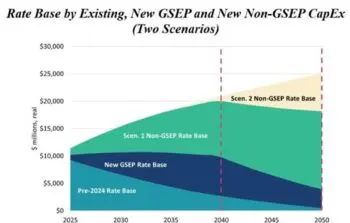
False claim #2: state laws requiring net zero by 2050, which are driving up costs for families and businesses.
As we wrote back in November, extensive modeling previously conducted by Massachusetts for the Commonwealth’s ‘2050 Decarbonization Roadmap’ and Clean Energy and Climate Plans (CECP) provide evidence for a much different trajectory for regional energy prices tied to achievement of 2050 climate targets. These studies included granular region-wide energy system modeling to arrive at their results for Massachusetts customers:
- The 2025/2030 CECP found: “The increased adoption of electrified transportation and heating systems means that the average Massachusetts household will spend less money on energy every year. Average overall household energy expenditures, which include transportation-related fuel costs (included as “energy” cost in this analysis), are projected to decline 8% by 2030 relative to 2019 levels, for an average household savings of $400 per year.”
- The 2050 CECP found: “the efficiency gains of electrification will result in lower household energy expenditures through 2050 (monthly bills for electricity and fuels). Transportation and household-related electricity and fuel expenditures are projected to decline by roughly 13% between 2030 and 2050, representing an average of nearly $600 (in 2021 dollars) in 2050 compared to 2030.
We also have to remember: pathways that invest in local energy resources, including renewable electricity generation and energy efficiency, create more jobs and demonstrate greater economic benefits by keeping money local compared to pathways more reliant on imported energy. For example, the “All Options” pathway from the Massachusetts 2050 Decarbonization Roadmap Study Economic and Health Impacts Report (which emphasized deep electrification and broad renewable electricity buildout) had 17% higher economic “output” (the broadest measure of economic activity) in Massachusetts per dollar invested than the “Pipeline Gas” pathway (which relied heavily on imported alternative fuels). Evidence of these benefits in action is highlighted throughout state clean energy industry reports conducted regularly, such as in Massachusetts, where in 2022, the industry contributed over $14b to Gross State Product, and in Maine, where the clean energy economy now accounts for over 2% of the state’s total workforce, more than 15,000 jobs.
False claim #3: energy efficiency programs are the culprit for rising energy bills this winter.
In response to complaints about energy affordability, some have blamed increased funding of the region’s cost-effective energy efficiency programs. This is no small source of irony – Mass Save®, for example, is a relatively small fraction of bills, but it is the most potent tool available to empower consumers to control their energy costs and protect them from fossil fuel price spikes. The vast majority of the bill for gas customers, around 70-75%, goes toward natural gas costs – relating to gas supply, distribution, and maintenance, compared to just 15-25% going toward energy efficiency. A similar dynamic is true on the electric side, where energy efficiency programs also represent only a small fraction in bills compared to fossil fuel and poles/wires costs: based on a recent bill from an Acadia Center staffer in Massachusetts, efficiency accounts for around 9% of a total National Grid electric bill.
Figure 6: Breakdown of Monthly Gas Bill for Massachusetts Customer in February (source: Eversource)
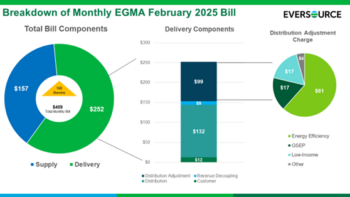
Unlike other energy costs, efficiency is the only investment that is required to pass cost-effectiveness testing. In fact, overall system costs would be billions of dollars greater without the cost reductions secured with efficiency; the more the benefits of improved energy efficiency are reduced, the costlier our energy system becomes.
Figure 7: Benefits of Current Three-Year Energy Efficiency Plans by State (source: Acadia Center)
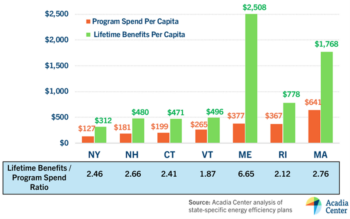
We should be investing even more to give homeowners, renters, and small businesses more tools to control their energy use and utility bills by increasing access to energy efficiency and implementing time-of-use (TOU) rates, plus expanding offerings for demand response and battery storage – which serve as far more cost-effective solutions for peak demand periods than the enormously costly reliability-must-run (RMR) contracts with fossil fuel power plants that ratepayers have had to bear in recent years. Increased oversight and accountability of utility distribution costs can also help drive savings for ratepayers, including via performance-based regulatory approaches to reduce inefficiencies and align incentives.
Looking back over time, the enormous benefits of the region’s energy efficiency benefits are self-evident. They have provided, as recently as 2023, 15% of gross electricity load for the entire region over the course of the year. In this way, energy efficiency helps meet the energy needs of our grid much in the same way as traditional supply resources like gas, oil, and coal. At the end of the day, the lowest-cost source of electricity is the one we never use.
Figure 8: Historic Benefits of NE Energy Efficiency Programs, 2012-2023 (source: Acadia Center)
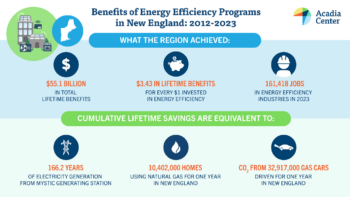
[1] https://www.nbcboston.com/weather/stories-weather/boston-total-snowfall-this-winter/3636399/


















